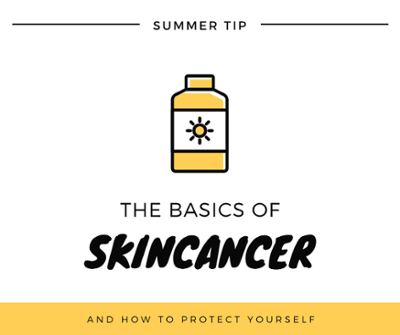The Basics of Skin Cancer
June 30, 2020

By Kayla Robertson, SIUE Senior Intern in Exercise Science
Summer is upon us and a lot of activities are moving outside. With longer days and warmer weather, it is inevitable that most of us will be exposed to at least a little bit of sun this summer, whether that be through activities such as hiking or kayaking or just hanging out with friends outside. It is important to remember that the sun does not discriminate when it comes to damaging our skin. Anyone regardless of age, gender, or race can develop skin cancer (1). According to the American Academy of Dermatology Association, 1 in 5 Americans develops skin cancer in their lifetime (1). Skin cancer is the most common form of cancer in the United States and has four different types (1).
Types of Skin Cancer
Basal Cell Carcinoma
Squamous Cell Carcinoma
Melanoma
Merkel Cell Carcinoma
UV radiation and How to Protect Yourself
According to the National Center for Environmental Health, there are three types of ultraviolet (UV) radiation: UVA, UVB, and UVC. All of UVC radiation and most of UVB radiation is absorbed by the Earth's ozone layer. UVA radiation passes through the ozone layer and penetrates deep into the skin, making it a threat to our health. UVB radiation is stronger than UVA, though not as consistent throughout the year and does not penetrate as deep (5). UVA rays cause premature aging, while UVB rays cause burns (6).
When it comes to protecting your skin, you should know where the UV radiation comes from. The most obvious source of UVA and UVB radiation is the sun. You may have heard of the UV index, a tool that helps you indicate how much protection from the sun is needed at any given time in the day. This is a scale from 0 to 11+, 0-2 being low risk, 3-7 being moderate to high risk, and 8+ being very high to extremely high risk (7). When there is a moderate risk it is suggested to use protection when outside, such as a water-proof, broad-spectrum sunscreen of SPF 30 or higher and wear protective clothing (7). When there is a very high risk, extra protection is needed and it is advised to use the same protection as a moderate risk while avoiding prolonged exposure to the sun (7).
Another way to protect yourself from UV exposure is to avoid indoor tanning beds. Indoor tanning beds have the same amount of UV radiation as you would get from the sun, if not more in some cases (8,9). If you want to get a tan without the possible radiation, the best thing to do is use a sunless tanner lotion or spray (8). A sunless tanner can help you get that desired tan without the danger, but be aware that the tanners do not double as sunscreen and you should continue to use sunscreen in company with the tanner (8). So whether you are hitting the trails or going to the lake, be sure to protect your skin and wear sunscreen!
For additional information and resources, visit:
Skin Cancer Foundation at www.skincancer.org
American Academy of Dermatology Association at www.aad.org/public
References:
(1) American Academy of Dermatology Association (2020). Skin Cancer. Retrieved from https://www.aad.org/media/stats-skin-cancer
(2) Cancer Treatment Centers of America (2020). Skin Cancer types. Retrieved from https://www.cancercenter.com/cancer-types/skin-cancer/types
(3) American Cancer Society (2020). Key Statistics for Basal and Squamous Cell Skin Cancer. Retrieved from https://www.cancer.org/cancer/basal-and-squamous-cell-skin-cancer/about/key-statistics.html
(4) American Cancer Society (2019). What is Melanoma Skin Cancer. Retrieved from https://www.cancer.org/cancer/melanoma-skin-cancer/about/what-is-melanoma.html
(5) National Center for Environmental Health (2020). UV Radiation. Retrieved from https://www.cdc.gov/nceh/features/uv-radiation-safety/index.html#:~:text=What%20are%20the%20different%20types,%C3%9710%2D9%20meters).
(6) American Academy of Dermatology Association (2020), Sunscreen FAQS, Retrieved from https://www.aad.org/media/stats-sunscreen
(7) Environmental Protections Agency (2019). UV Index Scale. Retrieved from https://www.epa.gov/sunsafety/uv-index-scale-0
(8) The Society for Pediatric Dermatology (2018). Risks of Indoor Tanning. Retrieved from https://assets.ctfassets.net/1ny4yoiyrqia/6qbJxp0rncbxIOCpRCJNYU/6090edd5d9fe369bcae845e4be0e9a25/spd_tanning_color_web.pdf
(9) American Academy of Dermatology Association (2020). Indoor Tanning. Retrieved from https://www.aad.org/media/stats-indoor-tanning
Categories: All Categories, internships, skin cancer, safety













